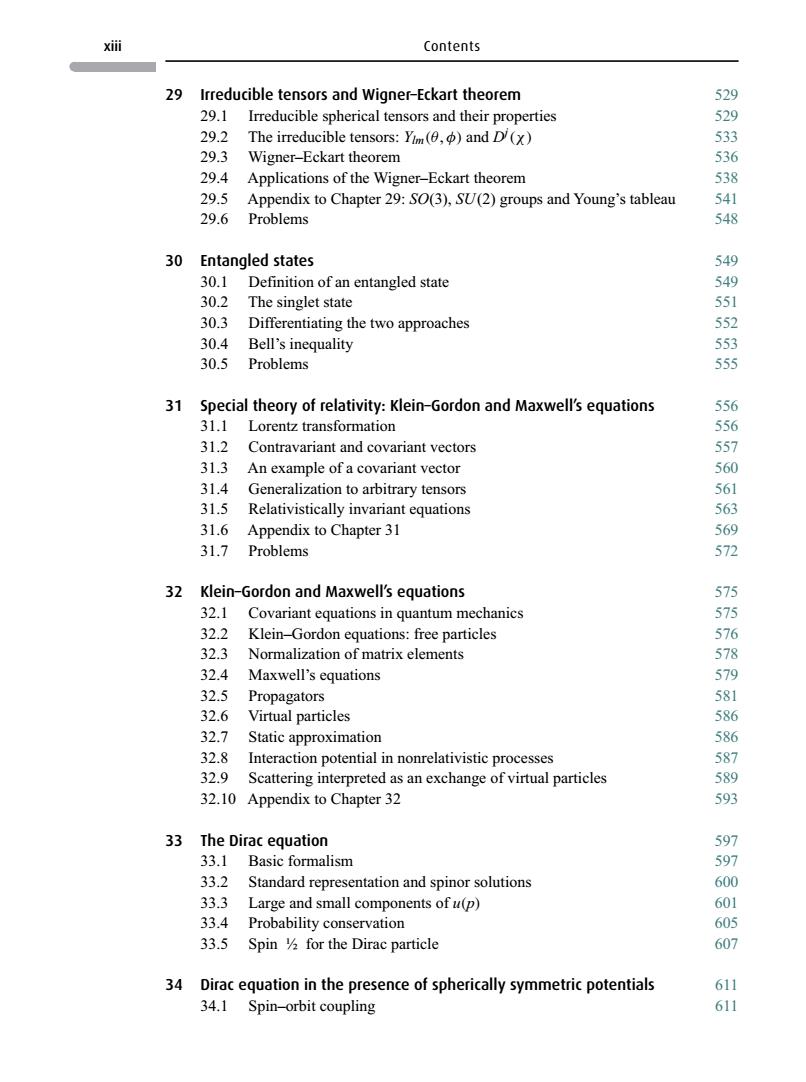正在加载图片...

Xiii Contents 29 Irreducible tensors and Wigner-Eckart theorem 529 29.1 Irreducible spherical tensors and their properties 529 29.2 The irreducible tensors:Yim(,and D/(x) 533 29.3 Wigner-Eckart theorem 536 29.4 Applications of the Wigner-Eckart theorem 538 29.5 Appendix to Chapter 29:SO(3),SU(2)groups and Young's tableau 541 29.6 Problems 548 30 Entangled states 549 30.1 Definition of an entangled state 549 30.2 The singlet state 551 30.3 Differentiating the two approaches 552 30.4 Bell's inequality 553 30.5 Problems 555 31 Special theory of relativity:Klein-Gordon and Maxwell's equations 556 31.1 Lorentz transformation 556 31.2 Contravariant and covariant vectors 557 31.3 An example of a covariant vector 560 31.4 Generalization to arbitrary tensors 561 31.5 Relativistically invariant equations 563 31.6 Appendix to Chapter 31 569 31.7 Problems 572 32 Klein-Gordon and Maxwell's equations 575 32.1 Covariant equations in quantum mechanics 575 32.2 Klein-Gordon equations:free particles 576 32.3 Normalization of matrix elements 578 32.4 Maxwell's equations 579 32.5 Propagators 581 32.6 Virtual particles 586 32.7 Static approximation 586 32.8 Interaction potential in nonrelativistic processes 587 32.9 Scattering interpreted as an exchange of virtual particles 589 32.10 Appendix to Chapter 32 593 33 The Dirac equation 597 33.1 Basic formalism 597 33.2 Standard representation and spinor solutions 600 33.3 Large and small components of u(p) 601 33.4 Probability conservation 605 33.5 Spin for the Dirac particle 607 34 Dirac equation in the presence of spherically symmetric potentials 611 34.1 Spin-orbit coupling 611xiii Contents 29 Irreducible tensors and Wigner–Eckart theorem 529 29.1 Irreducible spherical tensors and their properties 529 29.2 The irreducible tensors: Ylm(θ, φ) and Dj (χ ) 533 29.3 Wigner–Eckart theorem 536 29.4 Applications of the Wigner–Eckart theorem 538 29.5 Appendix to Chapter 29: SO(3), SU(2) groups and Young’s tableau 541 29.6 Problems 548 30 Entangled states 549 30.1 Definition of an entangled state 549 30.2 The singlet state 551 30.3 Differentiating the two approaches 552 30.4 Bell’s inequality 553 30.5 Problems 555 31 Special theory of relativity: Klein–Gordon and Maxwell’s equations 556 31.1 Lorentz transformation 556 31.2 Contravariant and covariant vectors 557 31.3 An example of a covariant vector 560 31.4 Generalization to arbitrary tensors 561 31.5 Relativistically invariant equations 563 31.6 Appendix to Chapter 31 569 31.7 Problems 572 32 Klein–Gordon and Maxwell’s equations 575 32.1 Covariant equations in quantum mechanics 575 32.2 Klein–Gordon equations: free particles 576 32.3 Normalization of matrix elements 578 32.4 Maxwell’s equations 579 32.5 Propagators 581 32.6 Virtual particles 586 32.7 Static approximation 586 32.8 Interaction potential in nonrelativistic processes 587 32.9 Scattering interpreted as an exchange of virtual particles 589 32.10 Appendix to Chapter 32 593 33 The Dirac equation 597 33.1 Basic formalism 597 33.2 Standard representation and spinor solutions 600 33.3 Large and small components of u(p) 601 33.4 Probability conservation 605 33.5 Spin ½ for the Dirac particle 607 34 Dirac equation in the presence of spherically symmetric potentials 611 34.1 Spin–orbit coupling 611